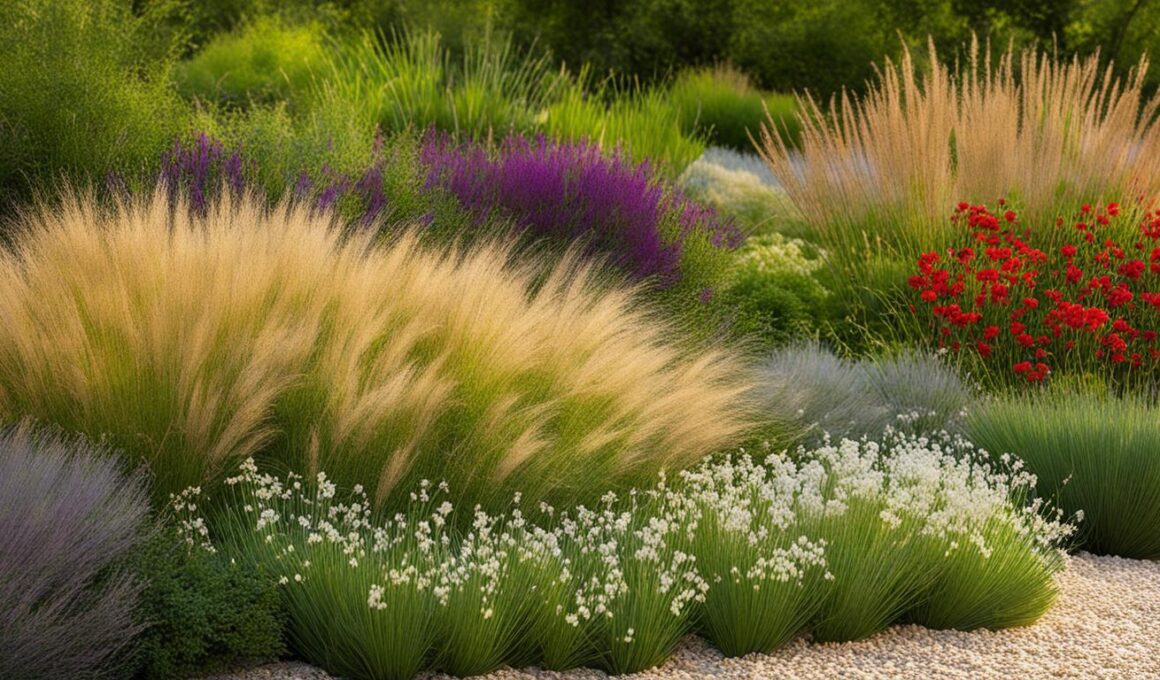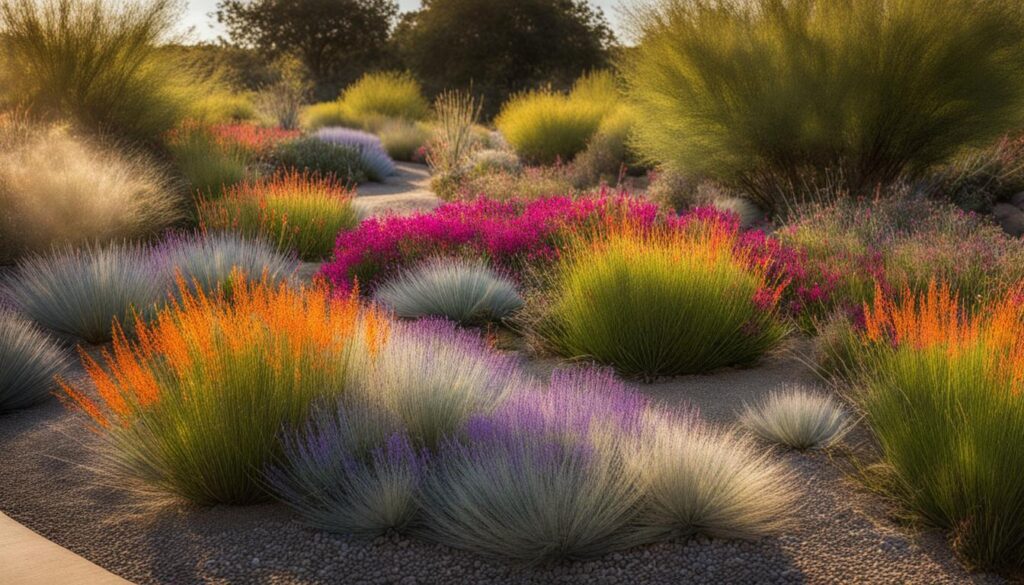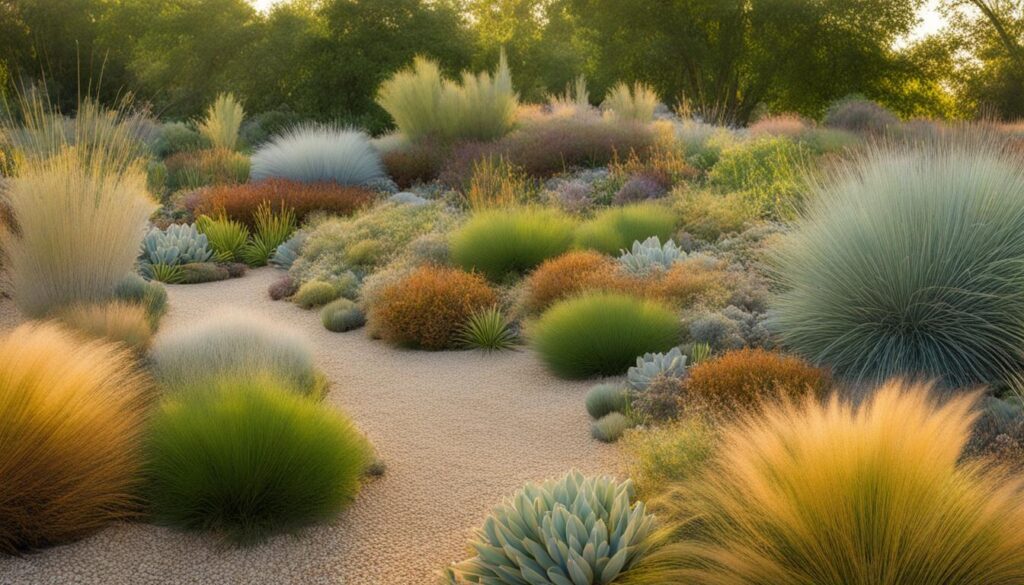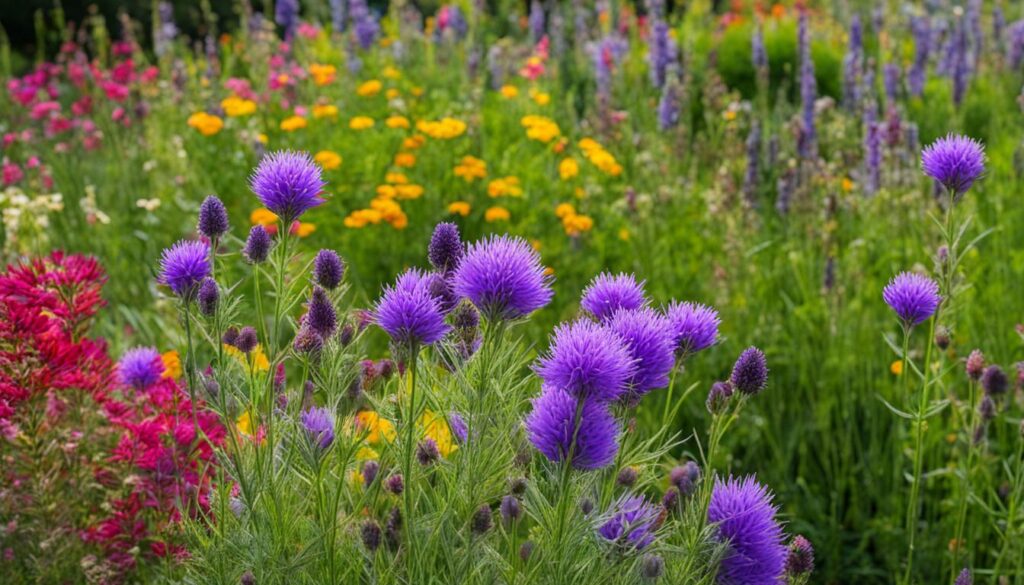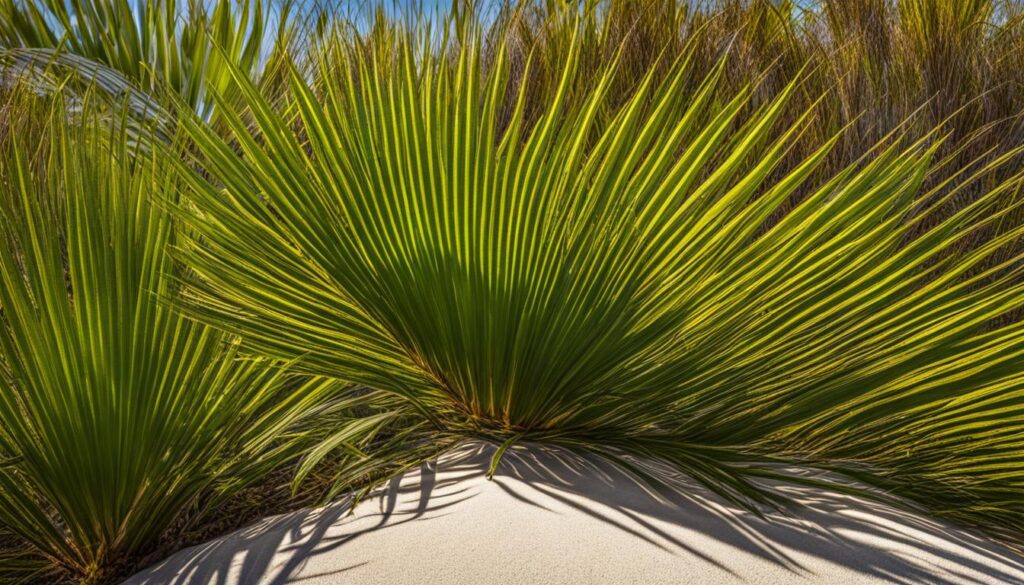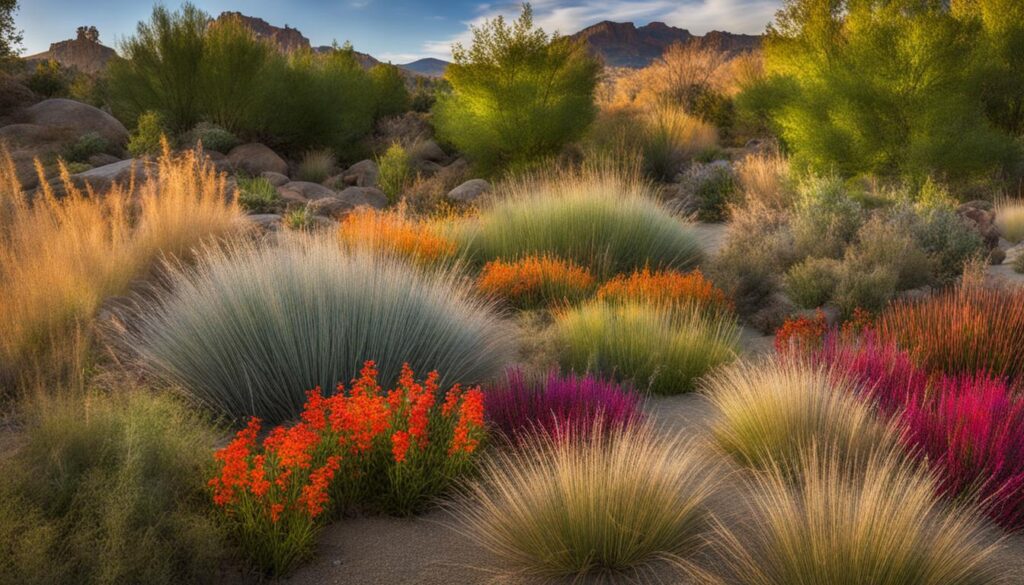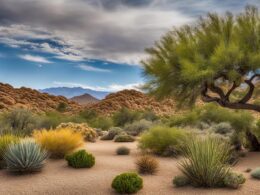Xeriscaping is an eco-friendly method of landscaping that aims to conserve water and protect the environment. By using native grasses and flowers in your landscape design, you can create a beautiful and sustainable garden that requires less water and maintenance.
In Florida, sandy Ball, a certified master gardener, emphasizes the importance of choosing the right plant for the right spot to ensure success in xeriscaping with native Florida plants. Native plants like Silver Buttonwood, Helianthus, Sunshine Mimosa, Coreopsis, and Gaillardia are great choices for xeriscaping, as they are salt-tolerant and can thrive in the region’s conditions.
Key Takeaways:
- Xeriscaping is an eco-friendly landscaping method for water conservation.
- Using native grasses and flowers in your design reduces water usage and maintenance.
- Choosing the right plants for your region, like Silver Buttonwood and Helianthus, ensures success in xeriscaping.
- Native plants like Coreopsis and Gaillardia are salt-tolerant and thrive in Florida’s conditions.
- Sandy Ball emphasizes the importance of selecting the right plant for the right spot in xeriscaping.
Benefits of Xeriscaping with Native Grasses and Flowers
Xeriscaping with native grasses and flowers offers numerous benefits that make it an attractive choice for homeowners who are passionate about water conservation and environmental protection. By incorporating native plants into your landscape design, you can enjoy the following advantages:
- Water Conservation: One of the primary benefits of xeriscaping with native grasses and flowers is its ability to conserve water. Native plants have adapted to the local climate and require less irrigation once established. This means you can significantly reduce your water usage and contribute to the preservation of this precious resource.
- Environmental Protection: By choosing native grasses and flowers for your xeriscaping design, you are supporting local ecosystems. Native plants provide food and habitat for pollinators, such as butterflies and bees, and attract other wildlife to your garden. This promotes biodiversity and helps maintain a healthy and balanced ecosystem.
- Low Maintenance: Native grasses and flowers are well-suited to the local environment, making them low-maintenance options for your xeriscaped garden. They are generally more resistant to pests and diseases, reducing the need for pesticides and fertilizers. Additionally, native plants require less frequent watering and often have natural defenses against drought and extreme weather conditions.
With these benefits in mind, it’s clear that xeriscaping with native grasses and flowers is not only a practical choice for water conservation but also a beautiful and sustainable way to enhance your outdoor space.
Native grasses and flowers in action
“One of the most rewarding aspects of xeriscaping with native grasses and flowers is witnessing the transformation of your garden into a vibrant and thriving oasis,” says Sandra Johnson, a landscape designer with over fifteen years of experience. “The beauty of native plants is that they are not only water-wise and environmentally friendly, but they also bring unique textures, colors, and scents to your landscape.”
Her favorite native grass, the Gulf Muhly Grass, adds a stunning burst of pink blooms in the fall, creating a focal point in any xeriscaped garden. “The contrast between the delicate pink flowers and the vibrant green foliage is simply breathtaking,” she explains.
Creating a xeriscaped garden with native grasses and flowers not only benefits the environment but also provides homeowners with a visually appealing and low-maintenance landscape. By embracing these water-wise and sustainable practices, you can create a beautiful outdoor space that you can enjoy for years to come. The key is to select the right plants for your region and design a thoughtful layout that maximizes their natural beauty. So why not start xeriscaping with native grasses and flowers today and make a positive impact on your environment?
Choosing Native Grasses for Xeriscaping
Xeriscaping in Florida requires careful consideration of native grasses that can thrive in the region’s unique climate and soil conditions. When selecting native grasses for your xeriscaping design, it’s essential to choose varieties that are both salt-tolerant and drought-tolerant. These grasses are better adapted to the challenging environmental factors of Florida and can continue to thrive even with limited water resources.
One excellent option for xeriscaping in Florida is the Silver Buttonwood (Conocarpus erectus), a versatile plant that can be used as both a shrub and a tree. It is highly tolerant of sun exposure, sandy soils, and salty conditions, making it an ideal choice for coastal areas. Another recommended native grass is Gulf Muhly Grass (Muhlenbergia capillaris), known for its stunning pink blooms. This grass is drought-tolerant and adds visual interest to any xeriscape garden.
Tips for selecting native grasses:
- Choose grasses that are salt-tolerant and can withstand the coastal environment.
- Look for grasses that are drought-tolerant and require minimal watering once established.
- Consider the height and growth habit of the grasses to ensure they fit well in your xeriscape design.
- Consult with local gardening experts or landscape professionals for additional guidance on selecting the best native grasses for your specific location.
By incorporating these native grasses into your xeriscaping design, you can create a beautiful and sustainable landscape that conserves water and thrives in Florida’s unique climate.
Incorporating Native Flowers into Your Xeriscaping Design
Native flowers are an essential element of a well-designed xeriscape garden in Florida. They not only add vibrant colors and beauty to your landscape but also serve as butterfly attractors and provide habitat for pollinators. When incorporating native flowers into your xeriscaping design, it’s important to choose varieties that are drought-tolerant and can thrive in Florida’s unique climate. By selecting the right native flowers, you can create a sustainable garden that conserves water and supports local ecosystems.
“Incorporating native flowers into your xeriscaping design can create a colorful and sustainable garden.”
One recommended native flower for xeriscaping in Florida is Helianthus, commonly known as the beach sunflower. This low-growing plant produces bright, sunflower-like blooms and can be used as ground cover. It requires very little maintenance and is drought-tolerant, making it an ideal choice for water-conserving landscapes. Another excellent native flower option is Sunshine Mimosa, a ground cover plant with distinctive pink flowers. This plant is not only drought-tolerant but also self-fertilizing, reducing the need for additional fertilization.
Coreopsis, Florida’s state wildflower, is another fantastic choice for xeriscaping. It features sunny, daisy-like flowers that attract butterflies and pollinators. Coreopsis is drought-tolerant and requires minimal watering once established. Gaillardia, also known as blanket flower, is highly salt-tolerant and adds vibrant orange and red blooms to your xeriscape garden. By incorporating these native flowers into your landscape design, you can create a visually appealing and sustainable garden that thrives in Florida’s climate.
Native Flowers for Xeriscaping Design in Florida:
- Helianthus (Beach Sunflower)
- Sunshine Mimosa
- Coreopsis
- Gaillardia (Blanket Flower)
Saw Palmetto: A Native Florida Plant for Xeriscaping
Xeriscaping with native plants offers numerous benefits, and one standout option for Florida landscapes is the saw palmetto. This native plant is well-suited for xeriscaping due to its adaptability and unique characteristics. Saw palmetto (Serenoa repens) is a shrub-like plant that can add a touch of Florida’s native flora to your xeriscaping design.
One of the key advantages of using saw palmetto in xeriscaping is its salt-tolerant nature. Florida’s coastal areas often have high levels of salt in the soil, which can be challenging for many plants. However, saw palmetto can thrive in these conditions, making it an ideal choice for xeriscaped gardens near the coast.
In addition to its salt tolerance, saw palmetto is also drought-tolerant. Florida experiences periods of dry weather, and xeriscaping with plants that can withstand prolonged periods without much water is essential. Saw palmetto’s ability to survive and thrive in drought conditions makes it a valuable addition to any xeriscaping project.
Saw palmetto is not only a resilient and adaptable plant but also plays a crucial role in the state’s ecosystem. It serves as an essential food source for native wildlife, including birds and mammals. The berries of the saw palmetto have been traditionally used for various medicinal purposes, including the treatment of prostate problems. Incorporating this native Florida plant into your xeriscaping design can create a sustainable and beautiful landscape.
Drought-Tolerant Native Plants for Xeriscaping in Colorado
Colorado’s diverse climate poses unique challenges for xeriscaping. However, there are many drought-tolerant native plants that can thrive in the region’s dry conditions while conserving water. Incorporating these plants into your xeriscaping design can create a resilient and sustainable garden that is both beautiful and environmentally friendly.
One excellent choice for Colorado xeriscaping is Liatris punctata. This native plant stores energy in its taproot, allowing it to survive even after a dry summer. With its stunning lavender-violet flowers, Liatris punctata adds a splash of color to your garden while requiring minimal watering. Another great option is Penstemon secundiflorus, which showcases architectural leaves and bright, lavender-violet spring blooms. This native plant not only thrives in Colorado’s dry climate but also attracts pollinators such as hummingbirds and butterflies.
Calylophus serrulatus, also known as evening primrose, is a subshrub that offers glossy, toothed leaves and beautiful yellow flowers. This drought-tolerant native plant adds texture and vibrancy to your xeriscaping design, requiring little water once established. Lastly, Cliffrose is a shrub with creamy yellow, rose-like flowers and small, evergreen leaves. Its ability to withstand harsh conditions makes it an ideal choice for Colorado gardens.
Drought-Tolerant Native Plants for Xeriscaping in Colorado:
- Liatris punctata
- Penstemon secundiflorus
- Calylophus serrulatus
- Cliffrose
By selecting native plants that are specifically adapted to Colorado’s climate, you can create a low-maintenance garden that conserves water and thrives in challenging conditions. These drought-tolerant plants not only provide beauty and biodiversity but also contribute to water conservation efforts in the region.
Is Xeriscaping with Native Grasses and Flowers the Most Effective Way to Conserve Water in Landscaping?
Yes, native grasses xeriscape landscaping is the most effective way to conserve water in landscaping. By using plants that are already adapted to the local climate, less water is required for maintenance. This not only saves water but also reduces maintenance costs and promotes biodiversity.
Conclusion
Xeriscaping with native grasses and flowers is an excellent choice for creating a sustainable and water-efficient landscape design. By incorporating drought-tolerant and salt-tolerant native plants, you can conserve water, save time and money, and support local ecosystems. Whether you’re in Florida or Colorado, xeriscaping offers numerous benefits and helps protect the environment.
By choosing the right plants for your region, you can minimize water usage while still enjoying a beautiful garden. Native grasses and flowers are adapted to the local climate, making them more resilient and requiring less maintenance. With xeriscaping, you can create a landscape that not only looks stunning but also contributes to water conservation efforts.
Embrace the beauty of native grasses and flowers while making a positive impact on water conservation through xeriscaping. By implementing sustainable landscaping practices, you can create a thriving garden that reflects the natural beauty of your region and supports the well-being of the environment.





